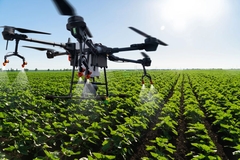F&B players ramp up renewable power to sustainably fuel food operations
24 Feb 2023 --- Eco-conscious consumers demand high-value products that benefit their daily lives, but their purchasing decisions must align with environmental ethics as they increasingly opt for food with a better carbon footprint. Investing in renewable energy is one key example of how companies are accelerating sustainability within their operations.
FoodIngredientsFirst examines how companies optimize practices and contribute to the global transition of saving energy as the cost of living continues squeezing F&B sectors.
From big brands to small-scale start-ups, businesses are ensuring consumers know how much they do to reduce their negative environmental impact. This is often through positive storytelling, promotion, and the growing range of label claims signifying how in line with the planet food can be.

Consumers also look out for greenwashing amid a surge in on-pack environmental claims. At the same time, brands can defend sustainability messaging with validated science and by starting initiatives and projects geared toward renewable energy.
Mondelēz is investing in renewable energy produced by photovoltaic power plants in Poland.One recent example is illustrated by Mondelēz International’s significant investment in renewable energy produced by photovoltaic power plants in Poland, a substantial contribution to the company’s long-term goal of achieving net zero greenhouse gas emissions by 2050.
GoldenPeaks Capital, a Swiss company investing in renewable energy sources across Europe, will supply approximately 126 gigawatt hours of carbon-free, renewable electricity yearly, produced by various solar power plants in Poland, with a contracted peak capacity of 109 megawatts.
This agreement aims to save over one million metric tons of CO2 and will approximately offset the electricity-related carbon footprint of eight Mondelēz International plants in Poland. The energy production is planned to start in March.
Reducing environmental impact
Paul Kennedy, Danone’s zero carbon director, says renewable energy significantly contributes to how Danone delivers a health halo for both people and the planet.
“For global businesses, delivering on environmental targets is directly connected to how we thrive and grow. We cannot grow as a business without acknowledging and acting to reduce our impact on the environment,” he tells us.
“We need renewable power to fuel our operations and our ambition is to grow while decarbonizing. Sourcing energy from renewable sources is a key lever to demonstrate our commitment to reduce emissions within our operations and empower partners and suppliers to lead on that,” he states.
Meanwhile, Katharina Stenholm, CSO for PepsiCo Europe, believes that “a better food system means better outcomes for people and the planet.”
“Renewable energy plays a key role in PepsiCo’s efforts to drive our sustainability agenda forward and ensuring we are using resources correctly is key to meeting our commitments and achieving our objectives in the short-mid term. We want to become net-zero by 2040,” she tells FoodIngredientsFirst.
Reducing energy costs
According to Stenholm, a combination of geopolitical and environmental factors has pushed alternative and renewable energy sources to the top of the global agenda.
“Projects like the biodigester we have just announced in our snack plant in Carregado (Portugal), which reduces gas consumption at the plant, will help us as we seek to meet our goals. These include moving to renewable energy sources, reducing greenhouse gas (GHG) emissions by more than 40% by 2030 and achieving net zero emissions by 2040.”
Meanwhile, increasing food prices means that many consumers are facing difficulties. “It’s our responsibility as a business to show that we are conscious of these challenges but still driving forward sustainability initiatives, as consumers are increasingly forced to choose between price and value,” Stenholm outlines.
As part of Danone’s Re-Fuel plan, the company is accelerating its decarbonization journey while scaling and embedding “energy excellence” across all factories. According to PepsiCo, “34% of respondents said they had stopped purchasing brands because of ethical or sustainability-related concerns.”
According to PepsiCo, “34% of respondents said they had stopped purchasing brands because of ethical or sustainability-related concerns.”
“The recent global energy crisis has highlighted the role of locally resilient and renewable energy. Through the Re-Fuel program, we are committing to reduce emissions by a further 47.2% by 2030.”
Investing in sustainable programs
In September 2021, PepsiCo launched Positive (pep+), its end-to-end transformation, accelerating efforts to help make the food system more sustainable, regenerative, and inclusive.
“From how we source ingredients, make and sell our products more sustainably; to how we inspire consumers through our iconic brands to make better choices, to how we support communities and contribute to improving livelihoods throughout our supply chain, we are embracing our role as a leader among our peers and in our communities,” explains Stenholm.
Last year, 12 countries in PepsiCo’s Europe sector sourced 100% renewable electricity for their manufacturing operations.
“I feel optimistic that in 2023 we will continue progressing our sustainability goals. This program drives action and progress through three key pillars of our business: agriculture, value chain and products.”
Kennedy at Danone believes that executing Re-Fuel Danone’s plan will “optimize its energy usage while significantly increasing its usage of renewable energy sources such as solar, biogas, biomass, and hydrogen power throughout our operations.”
The French food giant has already begun transitioning toward more renewable energy and uses 68.5% renewable electricity across its sites.
Circular value chains
PepsiCo’s new biodigester in Portugal is the company’s first in Southern Europe and will drive a 30% reduction in carbon emissions at the Carregado plant.
“We have another one in our Leicester (UK) facilities, and our ambitions are to replicate this model and create a more circular value chain in Europe,” adds Stenholm.
The biodigester will contribute to reducing gas consumption by allowing the facility to use the biogas produced during the process of anaerobic digestion (the biological process in which the material – potatoes peels, for example – in the absence of oxygen, through the action of a group of specific organic bacteria, is broken down into gaseous products or biogas).
“The biogas is then used directly as fuel in the various stages of production, as well as for sanitizing the production lines and heating the sanitary waters in the shower rooms and cafeteria,” Stenholm continues.
“We hope this project will be a case study showing PepsiCo’s sustainability best practices at a European level and be an example of circularity and reconversion at a local level since the project hopes to use the waste from outside our plant in the future.”
 The global energy crisis has highlighted the role of locally resilient and renewable energy.Meanwhile, Danone recently commissioned a new biomass boiler in New Zealand. This will be the country’s first dairy spray drying plant powered exclusively through biomass fuel and will be fueled by locally sourced sustainable forestry waste (within 50 km). “It will use waste residues from neighboring sustainably managed forests and will reduce CO2 emissions by 20,000 metric tons per year.”
The global energy crisis has highlighted the role of locally resilient and renewable energy.Meanwhile, Danone recently commissioned a new biomass boiler in New Zealand. This will be the country’s first dairy spray drying plant powered exclusively through biomass fuel and will be fueled by locally sourced sustainable forestry waste (within 50 km). “It will use waste residues from neighboring sustainably managed forests and will reduce CO2 emissions by 20,000 metric tons per year.”
“We are also harnessing the power of digital technology to drive efficiency improvements to reduce our energy footprint. A number of our sites are already leading the way and creating value,” he continues.
“For example, the World Economic Forum recognized our Opole factory in Poland for digital efficiency measures that have helped cut emissions by nearly 50% and waste by 21%,” he underscores.
Agricultural waste
Another example of how Danone is sourcing renewable energy is in Indonesia, notes Kennedy.
“We work in partnership with local farmers to gather their rice husks (an agricultural waste by-product) to produce energy to fuel our factory, and the ash is then returned to the local farmers to use as organic fertilizer.”
This is an example of resource efficiency, recognizing and optimizing “waste” as a renewable resource. “It is cost-effective for us, more sustainable, and creates an income for local farmers,” adds Kennedy.
Some companies are focusing on limiting energy consumption and avoiding the extraction of fossil-fuel resources to reduce their carbon footprints. Afyren, for example, produces chemical building blocks used in the food industry from sugar beet co-products, replacing feedstock that is almost always petroleum-derived. Afyren uses biotechnology – a patented fermentation process – to produce its carboxylic acids, which can be used as natural flavoring and preservative components.
“Proving that we can substitute non-renewable fossil fuels with biological resources to produce organic acids for multiple applications is even more important given the current international context,” says Joachim Merziger, CCO of Afyren.
“In some cases, co-products that would, for example, be spread into the fields or composted are transformed into valuable chemical ingredients. The only co-product left over from our process is a high-performance fertilizer suitable for organic farming,” a company spokesperson tells us.
Afyren has invested in a process that relies on renewable biomass and promotes fully circular, zero-waste production. The company also strives to save energy wherever possible. “Short supply chains are part of this effort. We purchase sustainably-produced energy when possible,” notes the spokesperson.
Additionally, the fermentation process Afyren uses to produce biobased acids is “much more energy efficient than the production process for petro-based acids.”
This is one of the reasons why Afyren’s acids have a carbon footprint 80% lower than the petro-based equivalents. smaller.jpg) Last year, Danone announced Re-Fuel Danone, to help make the company more sustainable, agile, efficient and resilient.
Last year, Danone announced Re-Fuel Danone, to help make the company more sustainable, agile, efficient and resilient.
Water use and waste management
Tate & Lyle is also working to deliver environmental commitments, as demonstrated by strong progress at its facility in Koog aan de Zaan (Koog) in the Netherlands on water use, waste management, and carbon emissions reduction.
Engineers at Koog have adapted the production process for the company’s Claria Clean Label Functional Starches to lower the product line’s carbon footprint and water use by 34% and 35%, respectively.
From early 2025, all Claria will be made using the more sustainable method developed at Koog under the new Claria G brand.
This production enhancement at Koog, which also purchases 100% renewable electricity, supports Tate & Lyle’s efforts to deliver on its science-based target to reduce Scope 1 and 2 carbon emissions by 30% by 2030 and to achieve net zero by 2050. Koog also beneficially uses 99.9% of its waste, contributing to the company-wide goal of beneficially using 100% of waste by 2030.
By Elizabeth Green













